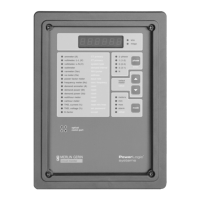Bulletin No. 3020IB9814
December 1998
58
SETTING UP ALARM/RELAY The circuit monitor (models CM-2150 and higher) can detect over 100 alarm
FUNCTIONS conditions, including over/under conditions, status input changes, phase
unbalance conditions, and more. (See Alarm Conditions and Alarm Codes
in the Circuit Monitor Reference Manual for a complete listing.)
Each alarm condition can be set up to automatically operate one or more
circuit monitor relays. Also, multiple alarm conditions can be assigned to
operate the same relay(s). For a description of the circuit monitor’s alarm/
relay functions, see Alarm Functions in the Circuit Monitor Reference Manual.
If you do not have POWERLOGIC application software, you can set up the
circuit monitor’s on-board alarm/relay functions from the circuit monitor’s
front panel. Perform this set up using the Alarm/Relay (AL.rLY) option, one
of the circuit monitor’s four setup options. For each alarm condition you can:
• Enable or disable the alarm condition
• Assign a priority level to the alarm condition
• Define any required pickup and dropout setpoints, and pickup and
dropout time delays
• Set up the circuit monitor to operate up to three relay outputs when the
alarm condition occurs
The circuit monitor’s relay outputs provide ten operating modes. (See Relay
Output Operating Modes in the Circuit Monitor Reference Manual for
descriptions of the modes.) When you assign an alarm condition to operate a
relay from the front panel of the circuit monitor, the circuit monitor
configures the relay to operate in Normal
mode. If Normal mode is not
acceptable, you’ll need to do one of the following:
• Set up the circuit monitor’s alarm/relay functions over the
communications link, using POWERLOGIC application software (which
lets you choose from the 10 available modes)
• First set up the alarm/relay functions from the circuit monitor’s front
panel, then change the relay’s operating mode by performing register
read/writes using either POWERLOGIC application software or the
circuit monitor’s Diagnostics option (see Reading and Writing Registers
from the Front Panel in the Circuit Monitor Reference Manual for
instructions on reading and writing registers using the Diagnostics
option)

